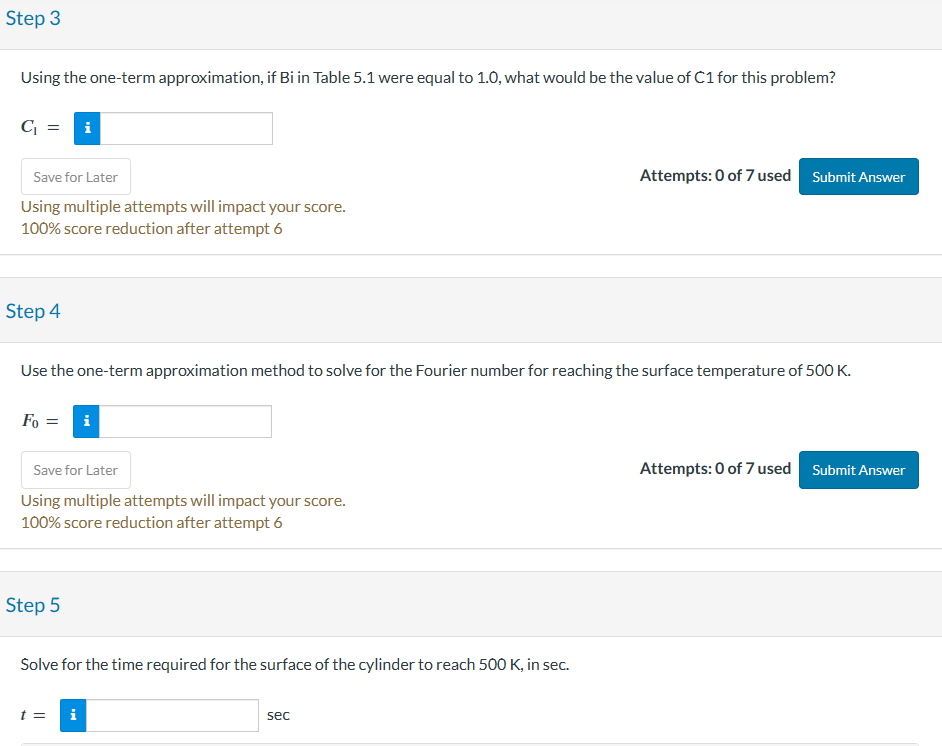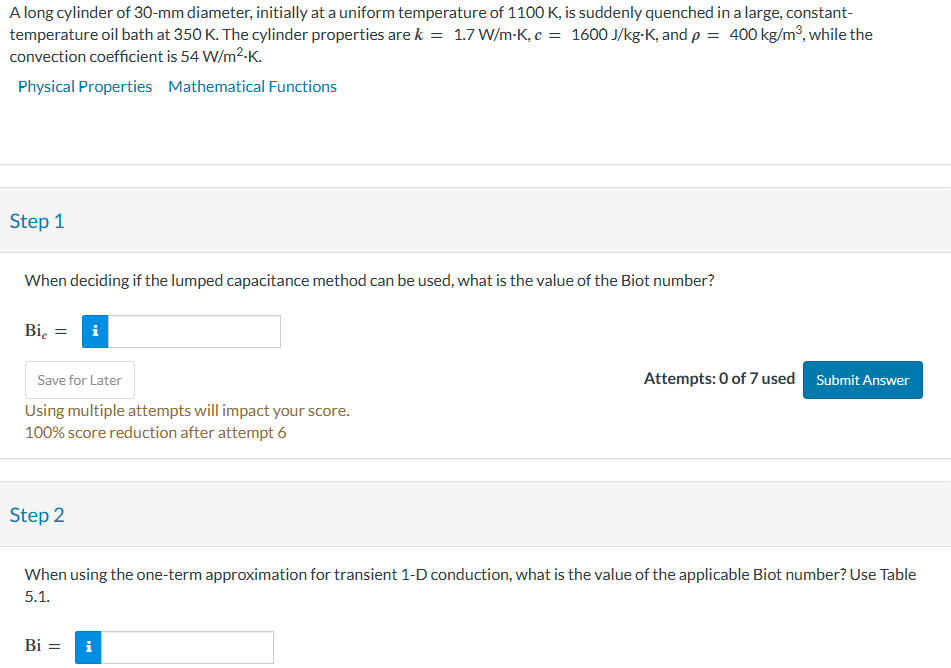A long cylinder of 30-mm diameter, initially at a uniform temperature of 1100 K, is suddenly quenched in a large, constant- emperature oil bath at 350 K. The cylinder properties are k = 1.7 W/m-K, c = 1600 J/kg-K, and p = 400 kg/m³, while the convection coefficient is 54 W/m².K. Physical Properties Mathematical Functions Step 1 When deciding if the lumped capacitance method can be used, what is the value of the Biot number? Bic i Save for Later Using multiple attempts will impact your score. 100% score reduction after attempt 6 Step 2 Attempts: 0 of 7 used Submit Answer When using the one-term approximation for transient 1-D conduction, what is the value of the applicable Biot number? Use Table 5.1. Bi = i
A long cylinder of 30-mm diameter, initially at a uniform temperature of 1100 K, is suddenly quenched in a large, constant- emperature oil bath at 350 K. The cylinder properties are k = 1.7 W/m-K, c = 1600 J/kg-K, and p = 400 kg/m³, while the convection coefficient is 54 W/m².K. Physical Properties Mathematical Functions Step 1 When deciding if the lumped capacitance method can be used, what is the value of the Biot number? Bic i Save for Later Using multiple attempts will impact your score. 100% score reduction after attempt 6 Step 2 Attempts: 0 of 7 used Submit Answer When using the one-term approximation for transient 1-D conduction, what is the value of the applicable Biot number? Use Table 5.1. Bi = i
Principles of Heat Transfer (Activate Learning with these NEW titles from Engineering!)
8th Edition
ISBN:9781305387102
Author:Kreith, Frank; Manglik, Raj M.
Publisher:Kreith, Frank; Manglik, Raj M.
Chapter6: Forced Convection Over Exterior Surfaces
Section: Chapter Questions
Problem 6.26P
Related questions
Question
Assume the Fourier number, Fo, is greater than or equal to 0.2 (note that you still need to calculate the Biot number, and possibly a second Biot number).

Transcribed Image Text:Step 3
Using the one-term approximation, if Bi in Table 5.1 were equal to 1.0, what would be the value of C1 for this problem?
C₁ = i
Save for Later
Using multiple attempts will impact your score.
100% score reduction after attempt 6
Step 4
Fo=
Use the one-term approximation method to solve for the Fourier number for reaching the surface temperature of 500 K.
Save for Later
Using multiple attempts will impact your score.
100% score reduction after attempt 6
Step 5
Solve for the time required for the surface of the cylinder to reach 500 K, in sec.
t =
i
Attempts: 0 of 7 used
sec
Submit Answer
Attempts: 0 of 7 used Submit Answer

Transcribed Image Text:A long cylinder of 30-mm diameter, initially at a uniform temperature of 1100 K, is suddenly quenched in a large, constant-
temperature oil bath at 350 K. The cylinder properties are k = 1.7 W/m-K, c = 1600 J/kg-K, and p = 400 kg/m³, while the
convection coefficient is 54 W/m².K.
Physical Properties Mathematical Functions
Step 1
When deciding if the lumped capacitance method can be used, what is the value of the Biot number?
Bic = i
Save for Later
Using multiple attempts will impact your score.
100% score reduction after attempt 6
Step 2
Attempts: 0 of 7 used Submit Answer
When using the one-term approximation for transient 1-D conduction, what is the value of the applicable Biot number? Use Table
5.1.
Bi = i
Expert Solution
This question has been solved!
Explore an expertly crafted, step-by-step solution for a thorough understanding of key concepts.
This is a popular solution!
Trending now
This is a popular solution!
Step by step
Solved in 5 steps with 1 images

Knowledge Booster
Learn more about
Need a deep-dive on the concept behind this application? Look no further. Learn more about this topic, mechanical-engineering and related others by exploring similar questions and additional content below.Recommended textbooks for you

Principles of Heat Transfer (Activate Learning wi…
Mechanical Engineering
ISBN:
9781305387102
Author:
Kreith, Frank; Manglik, Raj M.
Publisher:
Cengage Learning

Principles of Heat Transfer (Activate Learning wi…
Mechanical Engineering
ISBN:
9781305387102
Author:
Kreith, Frank; Manglik, Raj M.
Publisher:
Cengage Learning